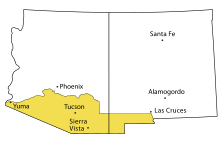| Gadsden Purchase of 1854 Venta de La Mesilla | |||||||||
|---|---|---|---|---|---|---|---|---|---|
| Expansion of United States | |||||||||
| 1853–1854 | |||||||||
 The Gadsden Purchase and main cities | |||||||||
| Area | |||||||||
• 1854 | 76,768 km2 (29,640 sq mi) | ||||||||
| Government | |||||||||
| • Type | Federal republic | ||||||||
| President | |||||||||
• March 4, 1853 – March 4, 1857 | Franklin Pierce | ||||||||
| Historical era | Westward expansion and Manifest Destiny | ||||||||
| 1846–1848 | |||||||||
• Treaty drafted[1] | 30 December 1853 | ||||||||
• Treaty approved by U.S. Senate | April 25, 1854 | ||||||||
• Treaty in effect | 30 June 1854 | ||||||||
| |||||||||
| Today part of | United States | ||||||||
The Gadsden Purchase (Spanish: Venta de La Mesilla "La Mesilla sale")[2] is a 29,640-square-mile (76,800 km2) region of present-day southern Arizona and southwestern New Mexico that the United States acquired from Mexico by the Treaty of Mesilla, which took effect on June 8, 1854. The purchase included lands south of the Gila River and west of the Rio Grande where the United States wanted the construction of what is now known as the Sunset Route, a transcontinental railroad, to be carried out, which the Southern Pacific Railroad later completed in 1881–1883. The purchase also aimed to resolve other border issues.
The first draft was signed on December 30, 1853, by James Gadsden, U.S. minister to Mexico, and by Antonio López de Santa Anna, president of Mexico.[1] The U.S. Senate voted in favor of ratifying it with amendments on April 25, 1854, and then sent it to President Franklin Pierce. Mexico's government and its General Congress or Congress of the Union took final approval action on June 8, 1854, when the treaty took effect. The purchase was the last substantial territorial acquisition in the contiguous United States, and defined the Mexico–United States border. The Arizona cities of Tucson, Yuma and Tombstone are on territory acquired by the U.S. in the Gadsden Purchase.
The financially-strapped government of Santa Anna agreed to sell the territory for $10 million[3] (equivalent to $270 million in 2023[4]). After the devastating loss of Mexican territory to the U.S. in the Mexican–American War (1846–48) and the continued unauthorized military expeditions in the zone led by William Carr Lane, New Mexico territorial governor and noted filibuster, some historians argue that Santa Anna may have calculated it was better to yield territory by treaty and receive payment rather than have the territory simply seized by the United States.[5]
- ^ a b Cite error: The named reference
Kemp2010was invoked but never defined (see the help page). - ^ Ibarra, Ignacio (February 12, 2004). "Land sale still thorn to Mexico: Historians say United States imperialism behind treaty". Arizona Daily Star. Archived from the original on May 3, 2007. Retrieved October 4, 2007.
- ^ Cite error: The named reference
Kluger1was invoked but never defined (see the help page). - ^ Johnston, Louis; Williamson, Samuel H. (2023). "What Was the U.S. GDP Then?". MeasuringWorth. Retrieved November 30, 2023. United States Gross Domestic Product deflator figures follow the MeasuringWorth series.
- ^ Deeds, Susan M. (1996). "Gadsden Purchase". Encyclopedia of Latin American History and Culture. Vol. 3. New York: Charles Scribner's Sons. pp. 1–2.